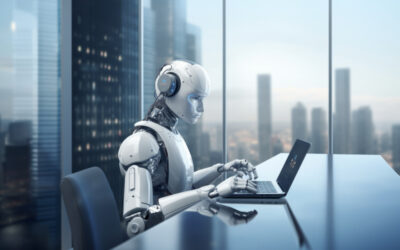Today, robotic process automation (RPA) is gaining huge momentum across all industries as companies have realized its significance in automating business processes and enhancing efficiency. In simple terms, Robotic Process Automation (RPA) involves the use of innovative technology to simplify high-volume, repetitive tasks and improve workflow. Key technology apps like artificial intelligence (AI) and machine learning incorporated by a robotic process automation company can help automate and streamline business operations and deliver a better customer experience. More and more industries are implementing RPA to perform tedious processes.
The retail industry is one such sector that has witnessed a significant setback due to the emergence of the COVID-19 pandemic and consequent restrictions. This in turn increases the pressure on retail leaders to offer better services, expand their market reach and maintain their customer base. The benefits offered by RPA to retailers are numerous – ranging from cost savings to improving customer service, which is why the retail sector was estimated to be one of the top five industries to leverage RPA in 2021.
Retail is a complex supply chain with several additional costs that keep adding at every stage. Therefore, any processes that improve or optimize costs can also improve the retailers’ profit margins. When it comes to retail, customers always expect a faster shopping experience with an uncompromising attitude towards error. According to eMarketer, retail sales have declined by 3 percent from 2019 to 2020, but e-commerce sales increased by more than 27 percent in the same period.
Moreover, it is expected that by 2023 online sales will account for a quarter of the overall retail industry. Therefore, lessening human intervention and process errors in an online sales business will provide a retail brand a clear competitive advantage.
How Does RPA Benefit Retailers?
In a multifaceted supply chain, retail is the last link, with costs being added at every phase. Therefore, any specific solution that helps reduce these expenses or optimize the product costing can help retailers improve profitability.
Robotic process automation (RPA) in retail supports a wide range of administrative, organizational and financial tasks. The technology can be instrumental in enhancing productivity and accuracy across a range of operations in retail. When these activities are automated, employees can spare time for complex and strategic roles. Here are some key benefits that robotic process automation offers to the retail sector
- Enhanced/improved compliance
- Improved user support
- Better inventory management
- Optimization of operational expenses
- More precise auditing
- Improved application integration
- Multi-tasking support
- Reduced risks in delivery
- Efficient planning with sales and inventory analytics in real-time
Key RPA Use Cases in Retail
As per recent reports, global online sales increased to 8.8 percent of total retail spending in 2018 (which was 7.4 percent in 2016). In fact, by 2023, online sales are expected to double – reaching up to 20-25 percent of the retail space. While comparing these growth figures to a considerably slow market growth, high labor costs and undependable supply – the retail industry can face significant challenges in the coming years.
Hence, the industry needs a complete restructuring of business processes from top to bottom. In addition, the industry is also expected to address the increasing need for consumer-centric business execution. Below discussed are some of the common tasks that can be automated within the retail space –
- Invoice Processing – When it comes to retailing, processing invoices can be a time-consuming and repetitive task. Employees constantly need to deal with a huge amount of paperwork and spend several hours on unproductive activities. Automating this aspect in retail can offer several benefits. With RPA in retail, collecting information, segregating data and processing bills become much faster and free of human errors.
- Business and Sales Analytics – Sales analytics is an important component for several retail decisions like new product introductions, trade promotions, and so on. With RPA, these tasks can be automated with real-time, data-driven reports on customer behavior and preferences with regards to specific products or their features/specifications. In fact, these reports can give a true picture on why certain customers are moving away and devise more strategies to maximize customer retention. RPA analytics can also perform predictive analytics, helping retailers to optimize stocks.
- Store Planning and Inventory Management – The conventional practice of arranging store layouts as per the needs and preferences of existing customers is still relevant. For instance, if a customer shops from a store on a regular basis, he/she knows where products are placed and is more likely to complete the purchases quickly. In fact, finding products quickly and without fuss is a big selling point (even online). However, one big issue is that human analysts alone cannot deal with the nuances of high-level sales data. With intelligent automation, they can organize the store to fit customer expectations, improve user experience, and boost revenue.
- Demand-Supply Planning – Demand supply planning involves designing specific strategies to satisfy the user’s demand of a particular product or service. The conventional method involved data collection, standardizing data, and scenario creation, etc. As it was a manual function, a lot of guesswork was involved. With RPA in the retail sector, businesses can make intelligent, data-driven decisions for asset management, customer support, supplier management, and capacity management.
- Marketing Planning – As trade promotions are an integral part of retail business operations, manually implementing these tasks can be expensive. Trade promotions require data gathering and analysis – without which the process cannot be done. However, with RPA, this task can be carried out efficiently and quickly. By analyzing huge volumes of data, the software can tell the retailer the products preferred by specific users – allowing them to offer special discounts or rebates.
- Product Categorization – Depending on local and global inventory units, retailers must categorize products. Several factors need to be considered based on different market constituents and definitions. This categorization can be improved by implementing RPA in retail. A study by the Everest Group says that automation can help improve product categorization accuracy by 98.5 percent. In short, utilizing RPA for retail can help correctly place several products in relevant categories based on multiple user-related factors.
- Customer Support and Call Center Processes – Customer support is the basis of RPA in retail – as all single use cases mentioned above are either directly or indirectly connected with providing customer support. However, one of the direct automation applications of RPA is offering customer guidance through automated bots 24/7. RPA bots send updates to customers to keep them in the loop from order payments to delivery. The software bot can also be configured to address simple user queries and take feedback from the sales team.
- Logistics and Supply Chain Management – As logistics and supply chain management is the heart of retail activities, smooth operation of supply chain is important for timely delivery of products to customers. Every retailer is expected to take the products from the suppliers and send them to the customer. However, the transition process can be complex and lengthy involving several processes like inventory level monitoring, customer support, shipment, order status tracking, reverse shipment and so on. RPA in supply chains and logistics enables increased collaboration between the various stakeholders – distributors, suppliers, and customers and quick turnaround. Furthermore, employees do not get involved in mundane tasks and this enables them to concentrate on value-added, strategic tasks, and handling exceptions.
- New Product Introductions – New product introductions are quite common and regular in a retail setup. As new products get launched, older products also have to be updated as several attributes like pricing and stock quantity are subject to changes much often. With RPA, real-time monitoring of customer preferences and alerts are automated. Client and customer opinions are monitored in real-time to tweak product rates, manage inventory and adjust pricing and production. In addition, costs can also be optimized by reducing unnecessary expenditure and optimal use of inventory.
- Enterprise Resource Planning (ERP) Management – ERP includes activities like billing, price changes, accounts payable and receivable, and more. Automating ERP activities helps reduce human efforts to a great extent. Further, this automated or RPA-powered ERP when integrated into the warehouse can help enhance inventory management efficiency.
- Document Exchange – Employing multiple people to validate and transfer documents involves excessive use of company resources. With AI and ML algorithms, companies can set up intelligent automated systems that can smartly validate documents of different types and formats. All this necessary information can be communicated to relevant personnel or departments. This reduces the risk of document misplacement and safeguards intellectual property better than ever before.
The COVID-19 pandemic has highlighted the importance of robotics- across various industries and the retail industry is no exception in this case. Automation in the retail industry can speed up business processes, free workers from tedious manual processes and allow them to focus on handling complex tasks. It helps streamline business operations as businesses can easily gather data and analyze it to make informed decisions. Though RPA offers many benefits, it can never replace human interactions. To ensure the accuracy of business processes and data, organizations can rely on experienced business process outsourcing companies




